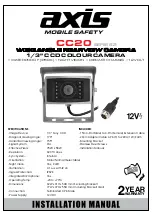
V1.02
Thom Hogan’s Complete Guide to the Nikon D300
Page 380
measure the distance between the two images. Called
phase
detection
, if the focus is in front of your subject, the image
lines will be closer together than expected; while if the focus
is behind the subject, the lines will be further apart than
expected.
The camera’s electronics look at the two image locations
reported by the autofocus sensor being used and instruct the
lens to move depending upon whether the lines are too close
together or too far apart. In AF-S lenses, there is a motor in the
lens that does the focusing; in all other Nikkor autofocus
lenses the camera drives the focusing cam of the lens with a
small screwdriver-like extension that sticks out of the lens
mount (and is slower and less predictable in terms of speed
due to different inertial loads in the lens).
A phase detection autofocus system has the benefit of being
fast and direct. Once a calculation of how much “off” the two
split images is made, the camera has precise knowledge of
how far to instruct the lens to move and in which direction.
That’s why, when there’s enough underlying contrast in the
subject to produce data that can be interpreted, the Nikon
autofocus system almost never “hunts” for the actual focus
point.
The drawback of all autofocus systems is that they have some
level of focus tolerance and susceptibility to small differences
in lenses.
Let’s discuss focus tolerance first. With subjects at midrange
distances with decent contrast, focus tolerance errors tend to
be insignificant—the difference between focusing at 12.10
and 12.12 feet is almost never perceptible in an image, even
with moderate telephoto lenses.
Where the focus tolerance can become a factor is with very
long telephoto lenses or with very close subjects (macro and
near macro ranges), especially when using maximum
apertures. Even small misses in focus precision can result in
















































